- Scientific name: Haliaeetus leucocephalus
- Species of Greatest Conservation Need (MA State Wildlife Action Plan)
- Special Concern (MA Endangered Species Act)
Description
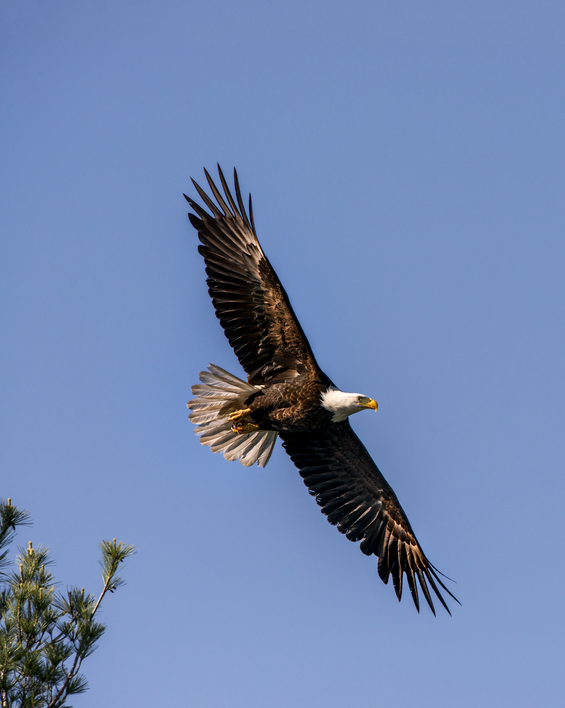
Bald eagle (Haliaeetus leucocephalus)
The bald eagle is one of the most impressive and majestic birds in North America. It is one of eight species in the genus Haliaeetus, the "fish" or "sea" eagles and is the only member of the genus that occurs regularly in North America. This species is one member of the family Accipitridae, all of which are in the order Accipitriformes. It is also the largest raptor (bird of prey) in Massachusetts, attaining a wingspan of 2.0 to 2.2 m (6.5 to 7.0 ft) with a body length of 0.9 m (3.0 ft), and a weight ranging from 3.6 to 6.6 kg (8 to 15 lb) at maturity. The sexes are similar in appearance but, as with most raptor species, females are notably larger than males.
Adult bald eagles are distinctively colored with a white head and tail, brown body, pale yellow eyes, and bright yellow beak and feet. The adult plumage is attained at 4 to 5 years of age. The plumage of immature bald eagles may vary considerably as immatures go through a sequence of plumage types before reaching maturity. These plumages include a uniformly dark phase in the first year, followed by phases with various amounts of white on the belly, back, underwings, tail, and head. The eye and beak color also change with age, from dark brown and blackish-gray at hatching to bright yellow in adults. In all feathered stages, the tail is rounded, and the lower half of the tarsus is unfeathered. Bald eagles fly with heavy, deep strokes and soar on flattened wings. In silhouette, the beak, head, and neck are almost as long as the tail.
Life cycle and behavior
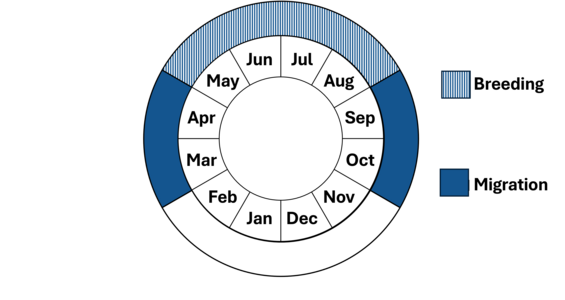
Phenology in Massachusetts. This is a simplification of the annual life cycle. Timing exhibited by individuals in a population varies, so adjacent life stages generally overlap each other at their starts and ends.
Courtship occurs in mid- to late winter and is a spectacular sight consisting of aerial loops, cartwheels, dives, and ending with the prospective mating pair locking their talons together and diving straight downward for hundreds of feet while spinning head over heels. Bald eagles may live up to 30 years, but mortality is relatively high in the immature age classes. They mate for life, but if one member of a pair dies, the other will actively court another mate. Sexual maturity is reached at four to six years of age, but the birds may be considerably older before they breed for the first time.
The breeding season for bald eagles in Massachusetts begins with courtship during late fall or early winter. After courtship, the mated pair builds a large nest during December–February. The nest is constructed with large sticks and lined with sprigs of pine, grasses, and other soft materials. The male eagle collects the nest material and delivers it to his mate, who is responsible for most of the actual nest construction. Once the nest site is chosen, the mated pair will usually return every year to the same site and add to the existing structure. Nests are located in hardwoods or conifers from 9-37 m (30-120 ft) above the ground and may measure up to 3.6 m (12 ft) high and 2.6 m (8.5 ft) wide, with a weight of hundreds of pounds. Trees selected for nesting (and sometimes for roosting and perching) tend to be relatively large and, preferably, taller than their surroundings. Ideally, the nest lies below the top of the crown in a live tree, where the young are sheltered from the elements but the parent birds are still afforded adequate aerial access (generally, from the direction of the nearest water).
The female bald eagle lays one to three (two average) dull white eggs several days apart, usually during a period between early March and early April. The eggs are incubated (mostly by the female) for approximately 35 days until hatching. The eggs do not hatch at the same time, giving the first hatchling a significant advantage over its siblings. Competition for food is intense, and if the adult eagles are not able to provide enough for all of their young, the older chick will take advantage of its greater strength and size to seize most of the food provided by the parents, causing its younger siblings to starve. This behavior increases the probability that at least one chick will survive. Young eaglets grow rapidly and may eat up to two pounds of fish per day. Ten weeks after hatching, they begin to make short flights from the nest, spending much time with the parent birds observing the adults as they catch and find food. By late fall, the adults will no longer care for their young, and the fledgling eaglets begin life on their own. The entire breeding cycle, from nest construction to fledging of young, lasts 6-8 months. Most bald eagles appear to nest within 200 miles of where they hatched.
When available, fish (both marine and freshwater) is the bald eagle's preferred food. Fish may be captured by swooping from a perch or by coursing low over the water and dropping straight down when a fish is spotted. An eagle may plunge into the water to capture fish and may also steal fish from an osprey by harassing it until it drops its catch. Prey too large to carry may be dragged to shore. Birds, especially waterfowl, are sometimes taken by bursting into a large flock and pursuing a straggler until it tires and can be captured. Bald eagles also take crippled waterfowl and seabirds, small mammals and carrion, particularly dead fish. In winter, eagles of all ages may gather in large numbers at areas with open water where fish or waterfowl are abundant. This "social grouping" is believed to facilitate locating and acquiring food and may possibly aid in establishing or maintaining pair bonds.
Population status
Breeding bald eagles were extirpated from Massachusetts during the early 1900s. However, from 1982 to 1988, forty-one young bald eagles from Michigan and Canada were relocated to Quabbin Reservoir in Massachusetts. Following this restoration effort, bald eagles were confirmed to breed successfully in the state by 1989. Eagle numbers have increased slowly but steadily since that time. During 2024, at least 88 pairs of bald eagles maintained breeding territories in Massachusetts. Population abundance in Massachusetts is limited mainly by the amount of potential breeding habitat (i.e., number of large water bodies surrounded by mature forest and having shallow waters and abundant fish). Population viability is limited mainly by the species’ rarity and the possibility of catastrophic events (e.g., storms, disease).
Distribution and abundance
Bald eagles occur from Alaska and Canada south throughout the United States to Florida and Baja California. In the lower 48 states, they occur throughout the area where suitable habitat exists. High densities occur in Maine, Florida, the Chesapeake Bay area, the Mississippi Valley and the Pacific Northwest. In Massachusetts, nesting occurs statewide, and eagles use the Quabbin Reservoir, Connecticut River, Merrimack River, and Assawompset Pond complex throughout the year as both nesting and wintering habitat. Bald eagles also overwinter along the coast of Cape Cod, Buzzard's Bay and the islands of Martha's Vineyard and Nantucket. Historically, the bald eagle bred throughout most of North America prior to its widespread, well-publicized population decline during the early to mid-1900s. However, during the past several decades, the bald eagle has recolonized much of its historic range.
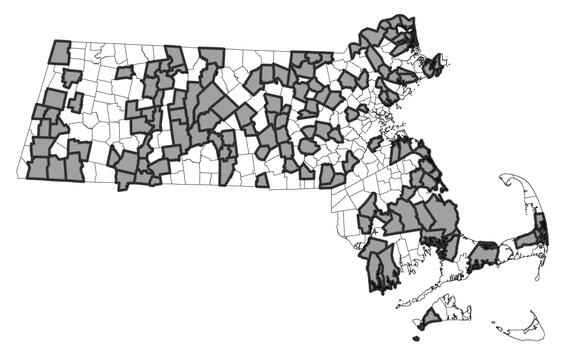
Distribution in Massachusetts. 1999-2024. Based on records in the Natural Heritage Database.
Habitat
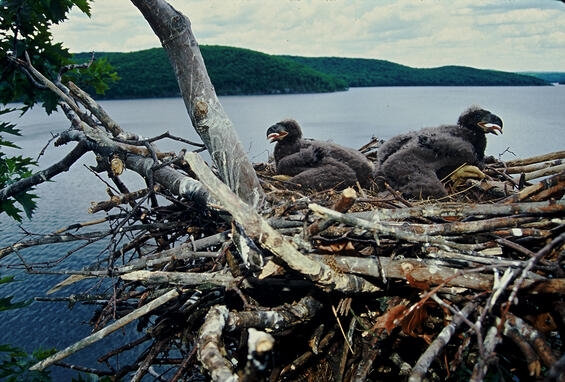
Bald eagle nest in Massachusetts.
Bald eagles usually inhabit coastal areas, estuaries, and larger inland waters. This species requires a great amount of shoreline habitat containing stands of forest for nesting and trees projecting above the forest canopy for perching, an adequate supply of moderate-sized to large fish, an unimpeded view, and reasonable freedom from human disturbance. Wintering eagles require suitable roost trees for night roosting. Some such roosts may be 20 km or more from feeding areas, occurring in favorable thermal environments where roost trees are protected from the wind by topography or other trees. The use of these protected sites helps minimize the energy stress encountered by wintering birds. The absence of a suitable night roost could limit the use of otherwise suitable habitat.
Healthy habitats are vital for supporting native wildlife and plants. Explore habitats and learn about conservation and restoration in Massachusetts.
Threats
The history of the bald eagle is one of human contradictions. On one hand, the bald eagle’s noble image has been portrayed on public documents, coin, currency, etc. as our nation's symbol since 1782, making it one of the most well-known creatures on earth. On the other hand, its environment has been reduced and degraded, and the bird itself was treated as vermin throughout North America for the better part of a century. As a result of deliberate killing by people (who incorrectly believed that eagles kill livestock or significantly threaten salmon fisheries), combined with substantial habitat loss (conversion of forest to development and agriculture), the bald eagle decreased in numbers in much of its range for many years. From 1917 to 1952, at least 128,000 bald eagles were believed to have been killed in Alaska where there was a bounty on the species. In the 20th century, the introduction of man-made chemicals and pollutants to the environment was implicated in death, increased susceptibility to death, and diminished reproductive success of bald eagles. DDT and its metabolites, as well as other organochlorines, are well-documented causes of eggshell thinning, breakage, and toxicity. The bald eagle was listed federally as an Endangered species in 1967.
A decline in human persecution and reductions in use of DDT and other toxins are credited with recent recoveries of bald eagle populations during the past quarter-century. The federal status of the species was upgraded to Threatened in 1995, and the species was removed from the federal list of threatened and endangered species in August 2007.
Over the last few years, a new threat has emerged, and numerous bald eagles have died from infection with highly pathogenic avian influenza (HPAI). Eagles are disproportionately impacted by the virus as they may prey upon sick birds or forage on infected carcasses.
Rodenticides (e.g., Second Generation Anticoagulant Rodenticides - SGARs) move up food chains and pose a threat to raptors when they consume prey that have ingested these chemicals. As a result, SGARs have been found in a high percentage of raptors that have been tested for them in Massachusetts, and it is well documented that they can kill individual raptors. However, their population-level impacts on raptors remain largely unknown.
Conservation
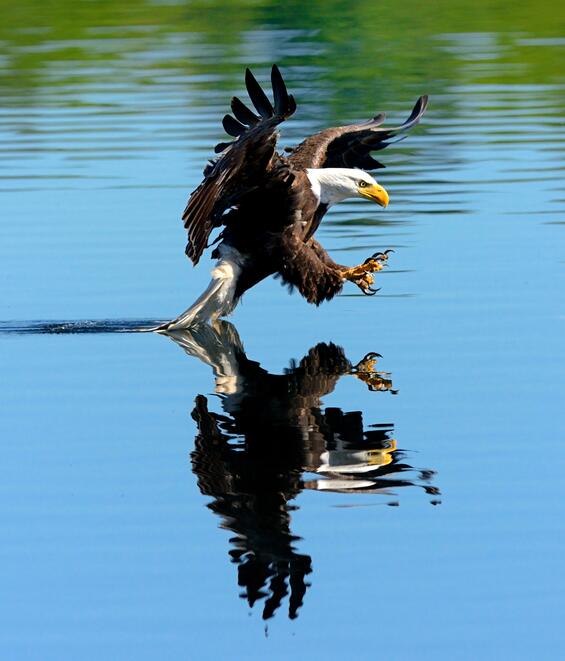
Adult bald eagle swoops low over the water.
Protection and enhancement of potentially suitable wetland and forest habitats, and maintenance of known breeding, roosting, and wintering areas will be critical to long-term conservation of bald eagles in Massachusetts. To achieve these objectives, landowners should first work to limit development near shorelines of large water bodies, as loss of nesting habitat is a primary threat to bald eagles in the state. Prevention, identification, and remediation of environmental contamination (e.g., lead, mercury, PCBs, and other toxic depositions) are also key to maintaining adequate foraging habitat and maximizing long-term reproductive success and survival of bald eagles. Landowners who wish to harvest timber near potential eagle habitat should consult the Massachusetts Forestry Conservation Management Practices (CMPs) for bald eagle; these practices, which are published by MassWildlife’s Natural Heritage and Endangered Species Program, provide guidance for protecting (or even enhancing) nesting and foraging habitat during forestry projects. Increased public education about the potentially detrimental effects of human disturbance on reproductive success of bald eagles is another measure that can be taken.
Conduct research to better understand the impacts of highly toxic rodenticides (e.g., SGARs) to raptor populations. Promote an integrated pest management approach that emphasizes the use of alternative pest control measures whenever possible to reduce negative impacts to wildlife. Coordinate with other state agencies to improve tracking and reporting of rodenticides found in wildlife and develop outreach materials for the public.
Although direct mortality does not appear to be a leading threat to long-term conservation of bald eagles in Massachusetts, every effort should be made to prevent avoidable deaths. Fishermen should be diligent in proper disposal of fishing line and equipment; eagles are known to accidentally ingest hooks and can become tangled in fishing line. Bald eagles are still taken by shooting on occasion; hence, education and strict law enforcement are additional measures that can be taken to improve survival.
Population monitoring at both the state and regional level will be an important tool to help determine population status, growth potential, and possible conservation setbacks. With continued sound management and increased public awareness, the future of the bald eagle should continue to be one of conservation's greatest success stories.
References
Bonney, R.E., Jr., J.W. Kelley, D.J. Decker, and R.A. Howard, Jr. 1981. Understanding Predation and Northeastern Birds of Prey. Ithaca, N.Y.: N.Y. State College of Agriculture/Cornell University.
Buehler, D. A. (2022). Bald eagle (Haliaeetus leucocephalus), version 2.0. In Birds of the World (P. G. Rodewald and S. G. Mlodinow, Editors). Cornell Lab of Ornithology, Ithaca, NY, USA.
Clark, W.S., and B.K. Wheeler. 1987. A Field Guide to Hawks of North America. Houghton Mifflin Company, Boston.
Fraser, J.D. 1985. The impact of human activities on bald eagle populations – a review. Pages 68–84 in J. M. Gerrard and T. M. Ingram, editors. The bald eagle in Canada. White Horse Plains Publishing, Headingley, Manitoba, Canada.
Fraser, J.D., L.D. Frenzel, and J.E. Mathisen. 1985. The impact of human activities on breeding bald eagles in north-central Minnesota. Journal of Wildlife Management 49:585–592.
Johnsgard, P.A. 1990. Hawks, eagles, and Falcons of North America. Smithsonian Institution Press, Washington, D.C.
Nisbet, I.C.T. 1989. Organochlorines, reproductive impairment, and declines in bald eagle Haliaeetus leucocephalus populations: mechanisms and dose relationships. Pages 483–489 in B. U. Meyburg and R. D. Chancellor, editors. Raptors in the Modern World. World Working Group for Birds of Prey, Berlin, Germany.
Northern States bald eagle Recovery Team.1983. Northern States bald eagle Recovery Plan. U.S. Fish & Wildlife Service. Washington, D.C.
Palmer, R.S. 1962. Handbook of North American Birds. vol. IV. Yale University Press, New Haven.
Robards, F.C., and J.G. King. 1966. Nesting and productivity of bald eagles, southeast Alaska – 1966. U. S. Bureau of Sport Fisheries and Wildlife Report, Juneau, Alaska, USA.
Stalmaster, M. 1987. The bald eagle. Universe Books, New York.
Terres, J.K. 1991.The Audubon Society Encyclopedia of North American Birds. Wing Books, New York.
Wiemeyer, S.N., C.M. Burick, and C.J. Stafford. 1993. Environmental contaminants in bald eagle eggs – 1980-1984 – and further interpretations of relationships to productivity and shell thickness. Archives of Environmental Contamination and Toxicology 13:529–549.
Contact
| Date published: | April 28, 2025 |
|---|